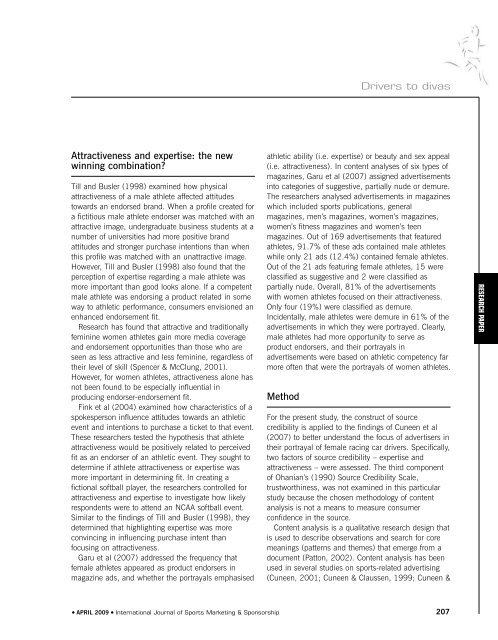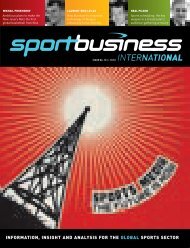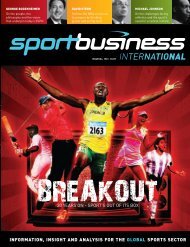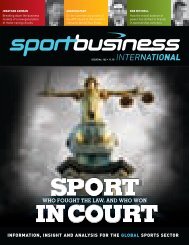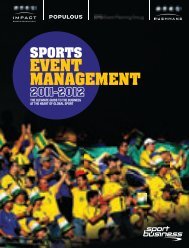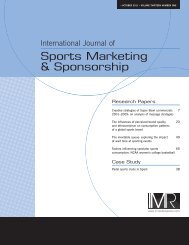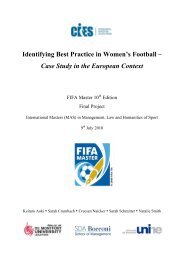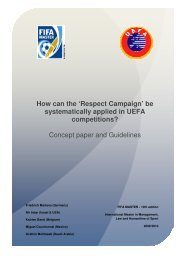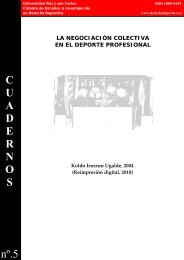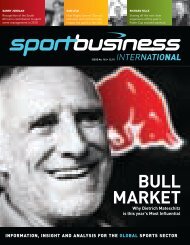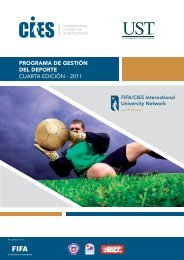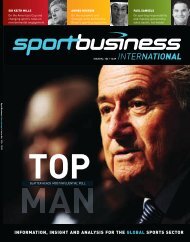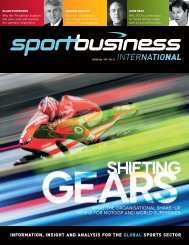Sports Marketing & Sponsorship - FIFA/CIES International University ...
Sports Marketing & Sponsorship - FIFA/CIES International University ...
Sports Marketing & Sponsorship - FIFA/CIES International University ...
- No tags were found...
You also want an ePaper? Increase the reach of your titles
YUMPU automatically turns print PDFs into web optimized ePapers that Google loves.
Drivers to divasAttractiveness and expertise: the newwinning combination?Till and Busler (1998) examined how physicalattractiveness of a male athlete affected attitudestowards an endorsed brand. When a profile created fora fictitious male athlete endorser was matched with anattractive image, undergraduate business students at anumber of universities had more positive brandattitudes and stronger purchase intentions than whenthis profile was matched with an unattractive image.However, Till and Busler (1998) also found that theperception of expertise regarding a male athlete wasmore important than good looks alone. If a competentmale athlete was endorsing a product related in someway to athletic performance, consumers envisioned anenhanced endorsement fit.Research has found that attractive and traditionallyfeminine women athletes gain more media coverageand endorsement opportunities than those who areseen as less attractive and less feminine, regardless oftheir level of skill (Spencer & McClung, 2001).However, for women athletes, attractiveness alone hasnot been found to be especially influential inproducing endorser-endorsement fit.Fink et al (2004) examined how characteristics of aspokesperson influence attitudes towards an athleticevent and intentions to purchase a ticket to that event.These researchers tested the hypothesis that athleteattractiveness would be positively related to perceivedfit as an endorser of an athletic event. They sought todetermine if athlete attractiveness or expertise wasmore important in determining fit. In creating afictional softball player, the researchers controlled forattractiveness and expertise to investigate how likelyrespondents were to attend an NCAA softball event.Similar to the findings of Till and Busler (1998), theydetermined that highlighting expertise was moreconvincing in influencing purchase intent thanfocusing on attractiveness.Garu et al (2007) addressed the frequency thatfemale athletes appeared as product endorsers inmagazine ads, and whether the portrayals emphasisedathletic ability (i.e. expertise) or beauty and sex appeal(i.e. attractiveness). In content analyses of six types ofmagazines, Garu et al (2007) assigned advertisementsinto categories of suggestive, partially nude or demure.The researchers analysed advertisements in magazineswhich included sports publications, generalmagazines, men’s magazines, women’s magazines,women’s fitness magazines and women’s teenmagazines. Out of 169 advertisements that featuredathletes, 91.7% of these ads contained male athleteswhile only 21 ads (12.4%) contained female athletes.Out of the 21 ads featuring female athletes, 15 wereclassified as suggestive and 2 were classified aspartially nude. Overall, 81% of the advertisementswith women athletes focused on their attractiveness.Only four (19%) were classified as demure.Incidentally, male athletes were demure in 61% of theadvertisements in which they were portrayed. Clearly,male athletes had more opportunity to serve asproduct endorsers, and their portrayals inadvertisements were based on athletic competency farmore often that were the portrayals of women athletes.MethodFor the present study, the construct of sourcecredibility is applied to the findings of Cuneen et al(2007) to better understand the focus of advertisers intheir portrayal of female racing car drivers. Specifically,two factors of source credibility – expertise andattractiveness – were assessed. The third componentof Ohanian’s (1990) Source Credibility Scale,trustworthiness, was not examined in this particularstudy because the chosen methodology of contentanalysis is not a means to measure consumerconfidence in the source.Content analysis is a qualitative research design thatis used to describe observations and search for coremeanings (patterns and themes) that emerge from adocument (Patton, 2002). Content analysis has beenused in several studies on sports-related advertising(Cuneen, 2001; Cuneen & Claussen, 1999; Cuneen &RESEARCH PAPER● APRIL 2009 ● <strong>International</strong> Journal of <strong>Sports</strong> <strong>Marketing</strong> & <strong>Sponsorship</strong>207


